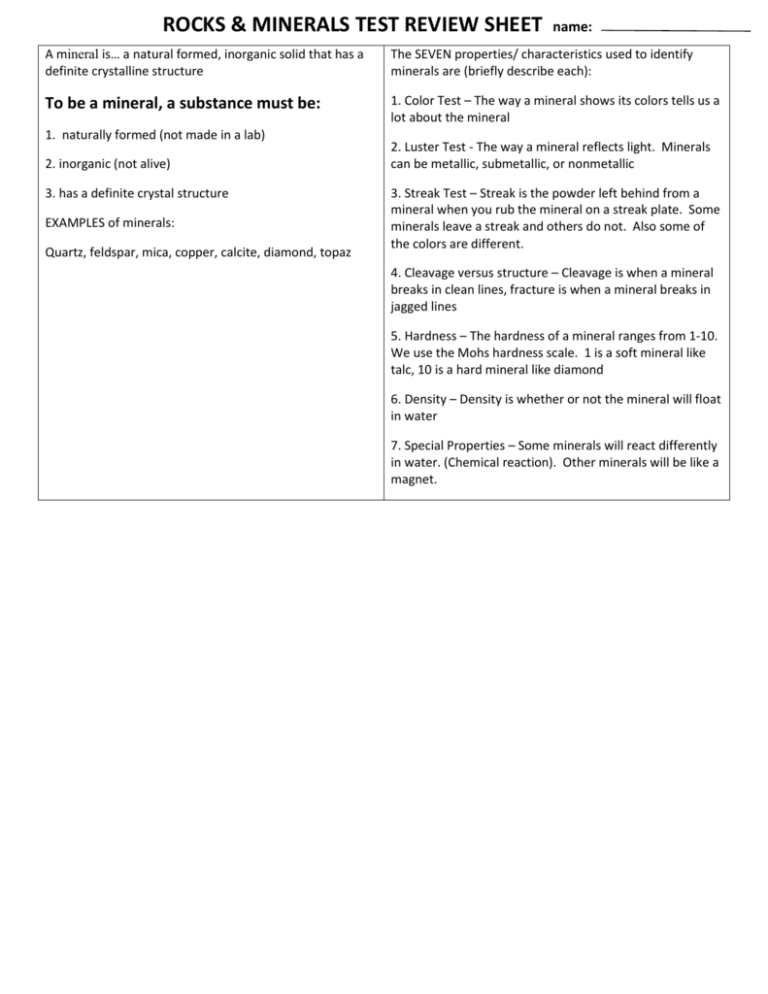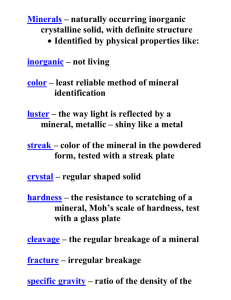A mineral is…
advertisement

ROCKS & MINERALS TEST REVIEW SHEET name: A mineral is… a natural formed, inorganic solid that has a definite crystalline structure The SEVEN properties/ characteristics used to identify minerals are (briefly describe each): To be a mineral, a substance must be: 1. Color Test – The way a mineral shows its colors tells us a lot about the mineral 1. naturally formed (not made in a lab) 2. inorganic (not alive) 3. has a definite crystal structure EXAMPLES of minerals: Quartz, feldspar, mica, copper, calcite, diamond, topaz 2. Luster Test - The way a mineral reflects light. Minerals can be metallic, submetallic, or nonmetallic 3. Streak Test – Streak is the powder left behind from a mineral when you rub the mineral on a streak plate. Some minerals leave a streak and others do not. Also some of the colors are different. 4. Cleavage versus structure – Cleavage is when a mineral breaks in clean lines, fracture is when a mineral breaks in jagged lines 5. Hardness – The hardness of a mineral ranges from 1-10. We use the Mohs hardness scale. 1 is a soft mineral like talc, 10 is a hard mineral like diamond 6. Density – Density is whether or not the mineral will float in water 7. Special Properties – Some minerals will react differently in water. (Chemical reaction). Other minerals will be like a magnet. A ROCK is a natural occurring solid mixture of one or more minerals and organic matter. Igneous: S Created from __Magma_ (below the surface) or Lava (above the surface) Sedimentary: Created through the processes of erosion and deposition. Then compaction of sediments form Sedimentary Rocks Metamorphic: Created when exposed to extreme heat & Pressure. Characterized by grain ____texture Clastic Extrusive: Where formed? A Above the Earth’s surface Forms when rock or mineral fragments, called clasts, are cemented together. Intrusive: Where formed? BeBeneath the Earth’s surface Speed of formation? Quickly Organic: Chemical: Formed when minerals crystallize out of a solution (Usually water reacts with a rock. E Example: Shale, Sandstone Examples Halite e diagram b Speed of formation? Slow Grain size? Coarse Grained - large Form from the remains of animals and plants Examples: Limestone, coal Characterized by grain size and texture. Foliated: NONfoliated: When the grains of the rock are aligned in bands or planes When the grains of the rock are not aligned in straight lines. Example: Schist, slate gneiss Examples: Marble, Quartzite Grain size? Small Examples: Examples: Examples: 1. How does sediment become a sedimentary rock? Compactions and cementation 2. How does a metamorphic rock become an igneous rock? A metamorphic rock would have top end up back in a volcano or be exposed to extreme heat causing it to melt and then re-harden 3. Describe two ways in which an igneous rock can become a metamorphic rock. WAY 1: ___Heat (pushed deep underground) _____________________________________________________________________________________ WAY 2: _Pressure - (Compressed deep underground) 4. How does magma become sediment? When magma cools, it often comes out of a volcano or out of a fault. It is not always the size of a rock. So it becomes sediment. The sediment is then compressed or compacted to make a sedimentary rock. 5. What happens when an igneous rock is exposed to heat and pressure? _____The igneous rock will change into a metamorphic rock. The heat and pressure changes the quality of the rock. 6. The processes of Weathering and Erosion create what? Sediments. Sediments can then create sedimentary rocks. 7. How does an igneous rock become a sedimentary rock? ____When an igneous rock, breaks into sediments, it can then compact and cement together forming a sedimentary rock. __________________________________________________________________________________________ 8. When a rock is exposed to heat and pressure, what type of rock is formed? Metamorphic.





